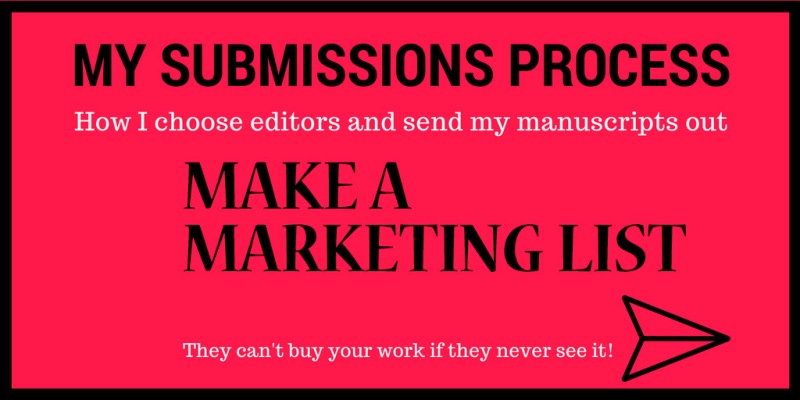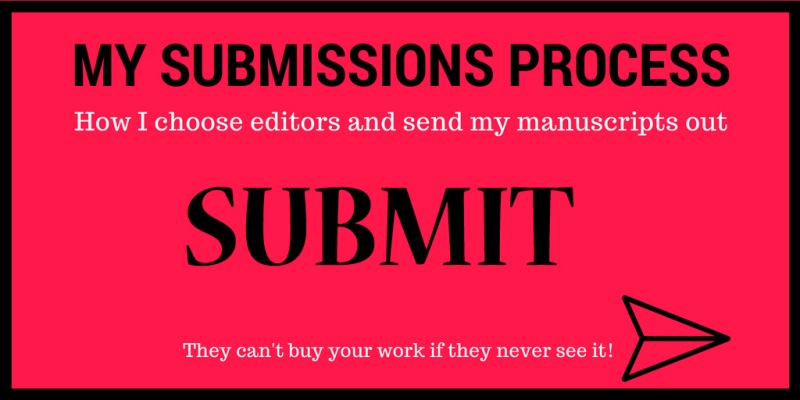This topic is complex and a bit overwhelming, but I’m going to try to break down my overall process into steps and explain it. Who to send your work to and how to send it–those are the most common areas that writers early in their journey have questions about. So…here’s my shot at explaining how I do this process.
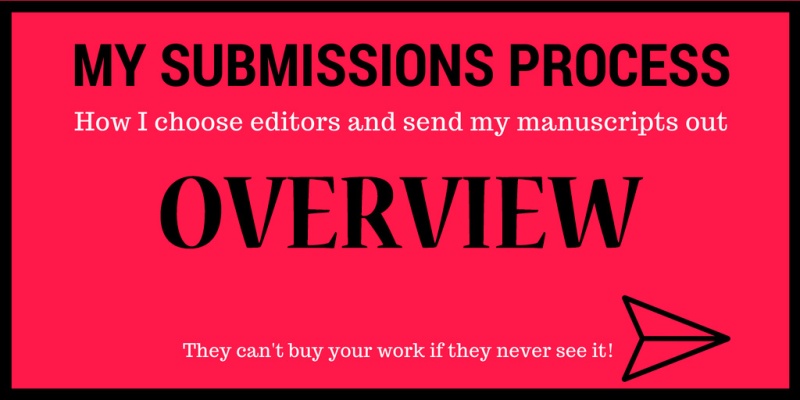
In this segment, I’m just going to share an excerpt from my book Making a Living Writing Books for Kids. It will give you an idea of my basic philosophy around submissions. Keep in mind, though, that this is what works for ME. If an entirely different system is working for YOU, then you should stick with that! There is no one right way to do this.
Find Homes for Your Love Writing
Getting your love projects published does rely on a certain amount of luck, as far as hitting the right editor in the right mood on the right day. But 90% of it, I believe, comes down to submitting your work smartly and consistently. Make your own luck!
Submit Work Regularly
Submitting your work regularly is a key requirement for getting published. But it takes lots of other habits to support that one big task. In order to submit regularly, I:
• read widely in the areas of picture books and poetry, my two specialties
• read a review journal regularly
• keep track of who’s publishing books I like in my areas (I do this through a combination of tracking books in Goodreads, keeping a publishers database in Excel, keeping abreast of publishing deals in PW Children’s Bookshelf and Publishers Marketplace, and studying publishers’ catalogs, websites, and booths at big conferences
Those are time-consuming but necessary habits if you do not have an agent.
Each month, I look at what submissions I plan to make the following month. Here’s what I do:
• check my list of manuscripts that I’m actively submitting
• mark the ones that are out with fewer than three editors
• check which editors on the market list I’ve made for that particular manuscript I might submit to next (making sure they don’t already have a different one of my manuscripts right then)
• study each of those editors and find somewhat similar titles that I can mention in my letter (Since you acquired XYZ, I thought this manuscript might appeal to you…)
• figure out contact information for each editor (from CWIM, their website, or Publishers Marketplace)
• write a fresh cover letter for each manuscript and each editor, making sure to update anything needed (like the editor’s name and the books I’m comparing my manuscript to, as well as any personal contact I want to remind her of)
• attach my manuscript
• send the mail or email
• note the submission in my submissions database
It’s easiest for me to do this in big chunks of time rather than a little bit each day. Every month, I typically spend one afternoon identifying my submissions for the coming month and which editors I’m sending them to and another afternoon actually putting together the submissions and sending them out.
I spend six to eight hours per month on submissions. I could do it all in one day if I had the stamina, and some people prefer that.
It’s exhausting, honestly. But it also fills me with hope to send off a bunch of letters or emails. I’m renewing old relationships, introducing myself and trying to start new ones, and learning which editors will respond to emails and which won’t. It’s all rather exciting and satisfying.
And when I get sick of doing it, I remember this mantra: Editors can’t buy it if you don’t send it!
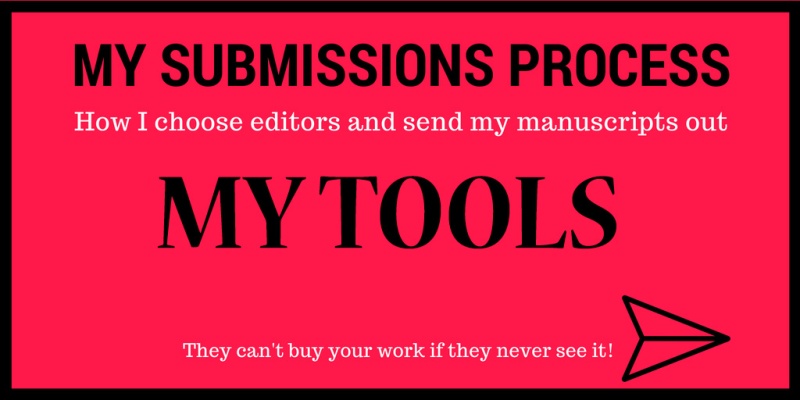 Part 2: Tools I use several tools, some free and some pricey, to help me research markets and submit my manuscripts. In this post, I’m going to describe the tools and very briefly say what I use them for. Future parts of this series will have more information.
Part 2: Tools I use several tools, some free and some pricey, to help me research markets and submit my manuscripts. In this post, I’m going to describe the tools and very briefly say what I use them for. Future parts of this series will have more information.
Databases I use Excel documents to keep track of many things. I don’t do anything super-fancy with them, and I’m sure I’m not using their full potential. But they work for me. And they work better than just Word documents, because I can sort my information in many ways (for instance, by last name, by date, by manuscript). Here are the main databases I have created to help with my research and submission. Publisher Database – Here’s where I put info about editors and publishers who publish the kind of writing I like to do. For example, I have no interest in writing YA, so I don’t bother to include info about YA editors.

The columns above are Publisher/Imprint/First Name/Last Name/Title/Email/Source of information/Note. Most commonly, the note area holds news of that particular editor buying a particular manuscript. I mostly track acquisitions of picture books and poetry collections. The yellow is just a flag to myself that I want to send that person something soon, and the dark purple is a note that that editor has replied and told me she only takes submissions from agents. (I don’t delete the editor altogether because I would probably forget and resubmit to them.) I find the info that I put into this database in several different places:
- PW Children’s Bookshelf
- com
- Conferences I attend or get notes from
- My writing community
Submission Plan Database – Here’s where I have my actively being submitted manuscripts down the left, and all the publishers I think might be a possible fit across the top. 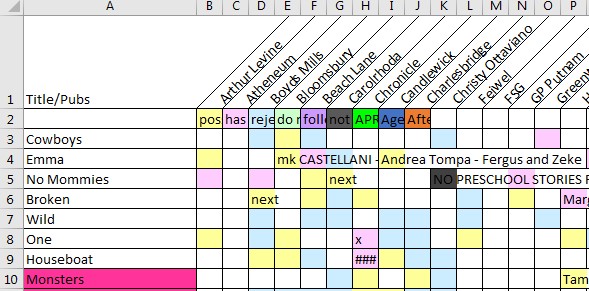 The colors mean different things. When I have a manuscript ready to start submitting, I go across my columns and put pale yellow for any publisher I think might be a possible fit. If I submit it, I change the box to pink. If it gets rejected, I change the box to blue. The other colors along the top row mean various complicated things you don’t need to worry about right now. If I pull a title from submissions in order to revise it, I mark the title hot pink. This is a new way of doing this for me. I used to just keep lists in a Word document. But it got too confusing. I have between 10 and 20 manuscripts out on submissions, and it’s really helpful for me to be able to see at a glance, “Hey, Publisher A is a possible market for Manuscript B. But I see Publisher A has a pink box filled in below it, so that editor is already looking at a different manuscript of mine.”
The colors mean different things. When I have a manuscript ready to start submitting, I go across my columns and put pale yellow for any publisher I think might be a possible fit. If I submit it, I change the box to pink. If it gets rejected, I change the box to blue. The other colors along the top row mean various complicated things you don’t need to worry about right now. If I pull a title from submissions in order to revise it, I mark the title hot pink. This is a new way of doing this for me. I used to just keep lists in a Word document. But it got too confusing. I have between 10 and 20 manuscripts out on submissions, and it’s really helpful for me to be able to see at a glance, “Hey, Publisher A is a possible market for Manuscript B. But I see Publisher A has a pink box filled in below it, so that editor is already looking at a different manuscript of mine.”
Submissions Database – You have to keep track of what you submit, to whom, when, and what the response is! This is crucial to your efforts to become a working writer. My submissions database has almost 1500 entries and goes back to 1996. Wowza. Here’s an excerpt from many years ago.  The columns I use are Keyword (a one-word description of the topic), Status (Sold, Abandoned, etc.), the manuscript’s actual Title, Format of submission (email, hard copy, by me, by an agent), Word count (so I can tell if and when I switched to a different version), Publisher, Editor, date I Sent the manuscript, what the Reply was, Date the reply came to me, and Tickler date (the date I want to follow up if I don’t get a response). I guess I wasn’t using those last two columns almost 20 years ago, but I use them today!
The columns I use are Keyword (a one-word description of the topic), Status (Sold, Abandoned, etc.), the manuscript’s actual Title, Format of submission (email, hard copy, by me, by an agent), Word count (so I can tell if and when I switched to a different version), Publisher, Editor, date I Sent the manuscript, what the Reply was, Date the reply came to me, and Tickler date (the date I want to follow up if I don’t get a response). I guess I wasn’t using those last two columns almost 20 years ago, but I use them today!
Children’s Bookshelf This is a free once or twice a week email newsletter from Publishers Weekly all about children’s literature. It announces job moves and promotions as well as a selection of recent deals made. There are also industry-related articles. You can subscribe at https://www.publishersweekly.com/pw/email-subscriptions/index.html?pwtracker=14&utm_campaign=newsAll&utm_source=pw&utm_medium=web
Publishersmarketplace.com This resource is not cheap, but it is probably the best investment I’ve ever made as an unagented writer. On this website, I can look up all the picture book acquisitions made in the past year, for instance (their database is not exhaustive, but it is very large and always helpful). Or I can look up all the acquisitions made by a certain editor in the past three years. If that editor has a Dealmaker page (many do), I can then get the editor’s snail mail and (most importantly) email address. I can find information here that would take me hours and hours to find elsewhere. The cost is $25 per month, or you can get a discount by signing up for an entire year. It will probably be most useful to you if you have several manuscripts ready to submit. But even with only one manuscript, I personally would buy a one-month membership and research my little heart out.
Horn Book Guide Online [ETA: They paused having this available for a while, and now it’s back. But I haven’t used it for a few years now. It was incredibly useful for me at one point, and I do recommend checking it out.] This is a paid searchable online database of all the reviews from the Horn Book Guide (which reviews many more titles than Horn Book). I mostly use it to find comp titles (titles I might compare my manuscript to in my cover letter) and to figure out which publishers might be a good fit for any particular one of my manuscripts.
My Writing Community Concrete resources are amazing, but my writing community, both off- and online, is also a source of marketing info. Because I talk with kidlit writers all the time and am a friendly but professional part of the community, I can sometimes ask flat-out, “Anybody know of an editor still at XYZ Publisher?” I did this recently in a Facebook Group for nonfiction writers, and two different writers published by the company I was asking about offered names, experiences, email addresses, and opinions. You can’t put a price on that kind of information and willingness to help! So, those are my basic tools. Remember, you might set up your databases a totally different way (and go about this entire process differently, too). I’m just sharing the way I do it in hopes that it will inspire you to figure out what will work for YOU!
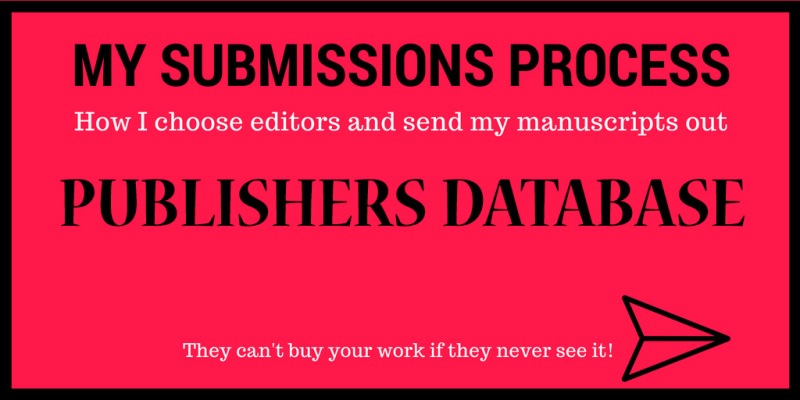 Part 3: My Publishers Database I thought I’d go into a little more detail about the database I keep of editors and publishers. This is a crucial part of my submission process, and I rarely meet anyone else who does this. Of course, that may be because they have better memories than I do. I have a very hard time remembering who publishes what, which editors are where, and so forth. And editors move around a lot, which does not help! I used to keep a database of all publishers and editors. That was a nightmare. I did it so that I could help Mentors for Rent clients with market research, but now that we no longer offer that service, I focus just on the editors and publishers who put out the kind of books I’m interested in writing. Probably the most useful source of information for my publishers database is the PW Children’s Bookshelf free e‑letter. Here’s a video of me going through a recent newsletter and gleaning info from it.
Part 3: My Publishers Database I thought I’d go into a little more detail about the database I keep of editors and publishers. This is a crucial part of my submission process, and I rarely meet anyone else who does this. Of course, that may be because they have better memories than I do. I have a very hard time remembering who publishes what, which editors are where, and so forth. And editors move around a lot, which does not help! I used to keep a database of all publishers and editors. That was a nightmare. I did it so that I could help Mentors for Rent clients with market research, but now that we no longer offer that service, I focus just on the editors and publishers who put out the kind of books I’m interested in writing. Probably the most useful source of information for my publishers database is the PW Children’s Bookshelf free e‑letter. Here’s a video of me going through a recent newsletter and gleaning info from it.
Highlights I hope you noticed:
- It takes time to learn an industry! Do not feel like a failure because you don’t recognize editors’ or publishers’ names! Start slowly. Pick one age or genre to focus on, and begin building your list, little by little. It’s like an investment account. What you put in today is not worth much. But as you build up your store of information, as it earns interest through your own submissions and attendance at writers’ conferences and such, it will become priceless.
- The newsletter is a starting point. I often have to do a quick Google search to check out a publisher.
- You are not trying to create a comprehensive market listing! If you have one or two editor names at a publisher, you might not want to add any more unless you see that an editor has acquired something very close in style or tone to your own work.
And that’s it! I find a database to be a flexible way to store and access the information I gather about editors and publishers in the kidlit industry. Maybe you will, too. Happy writing!
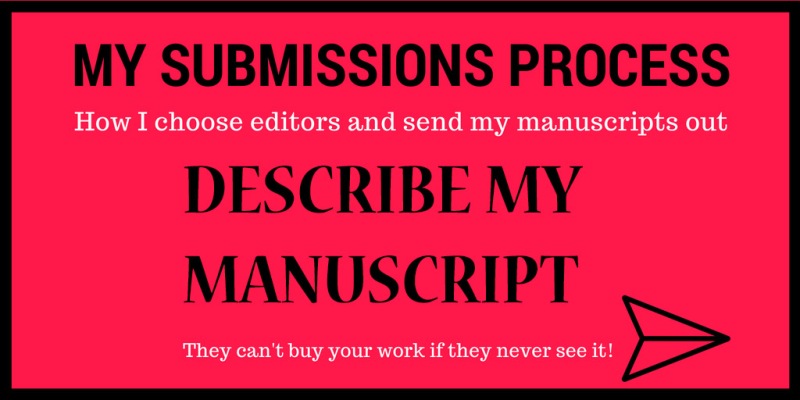 Part 4: Describe My Manuscript This seems so basic, but it’s amazing how many writers I’ve met who are trying to sell a manuscript without a basic understanding of what they’ve written and how it fits into the world of children’s book publishing. There are two prongs to this in my own process.
Part 4: Describe My Manuscript This seems so basic, but it’s amazing how many writers I’ve met who are trying to sell a manuscript without a basic understanding of what they’ve written and how it fits into the world of children’s book publishing. There are two prongs to this in my own process.
- Figure out what genre and format my manuscript belongs to, as well as who its key audience is
- Come up with words to describe my manuscript when I send it out
Genre and format and audience
If you have not read several hundred children’s/ya books published in the past 3 years, you have probably not read enough to have absorbed the information you need to help categorize your own writing. In brief (very brief), here are the basic categories.
- Board books for ages 3 and younger, often 50 words or fewer, printed on cardboard
- Picture books for ages 3–8, often 500 words or fewer (nonfiction might be longer)
- Easy readers for kids in grades K‑2 who are learning to read, generally 200‑1200 words, depending on intended audience, usually sold in series
- Chapter books for grades 1–3, generally 1500-10,000 words
- Middle-grade novels for grades 3–6, around 10,000–50,000 words
- Young adult novels, for ages 12 and up, around 40,000 words and up
- There are some other smaller categories, like tween books, graphic novels, and older nonfiction books.
(Check out Lisa Bullard’s Get Started Writing for Children for a terrific explanation of these categories.) You need to do LOTS of reading to become comfortable with the terms publishers use to categorize books and to become skilled at categorizing your own books, especially if you are writing anything that bends or blends genres and formats (as many of my own books do). I look at each of my manuscripts and really think about how I will categorize it to market it. Most of my manuscripts are picture books, which is simple enough. But that’s not all. Meet My Family, for instance, conveys a lot of nonfiction information about animal families, but it is told first-person from the points of view of many young animals. So it’s clearly not a traditional nonfiction picture book. Here’s how I described it when I first sent it to my editor at Millbrook, with whom I already had published several books:
My Family Is My Own — In a combination of verse main text and prose sidebars, a variety of young animals (each with its own voice) share the pros and cons of their parents’ parenting styles. [965 words with sidebars] Excerpt: I’m in charge of all my meals. [White rhino] I have always picked my own food, since right after I was born. I stand. I graze. I find tasty grasses and plants, just like the elders do. Mi madre brings me lunch. [Wood stork] I do not leave my nest yet. When I was very small, mi madre y padre used to throw up entire fish into my bill. Now they pass the fish from their bill to mine. We’ve lived one place since I was born. [Beaver] I’m almost two, and I live here in the lodge with my parents. I help fix things when they break! I’m great at jamming sticks into the lodge walls. Soon, I’ll leave this lodge and build my own… We move around a bunch. [Orangutan] I sleep high in the trees. My mother builds us a new sleeping nest nightly. I never know where I’ll be, but she is always right beside me. And here are some other possibilities that I think might hit that sweet spot of providing information, but delivering it in an unexpected way…
So I indicated right away through the details I shared that it was not straight nonfiction. Had it been a submission to a new-to-me editor, I would have been even more straightforward, perhaps saying something like, “This is nonfiction information delivered through the fictional voices of a variety of young animals.”
Descriptive words/phrases for my manuscript
But I have to do more than just categorize my manuscript. I have to describe it in an appealing way. The way I’ve been approaching this for a while has been the six-word framework I first learned from Verla Kay. (You can read about it here: https://mentorsforrent.wordpress.com/2017/08/15/the-quick-pitch-describing-your-manuscript-in-two-sentences/) Here’s part of my database (yes, I have a database for this, too) that shows my six words/phrases for several of the manuscripts I’m currently submitting.

B = describe the main character
C = summarize the tone of the book
D = identify the pace of the book
E = name the main character’s big problem
F = share the flavor of the manuscript (this is often another aspect of the tone of the manuscript)
G = describe the ending in terms of how it makes either the character or the reader feel
You’ll see my own words and phrases aren’t necessarily textbook perfect nor consistent. That doesn’t matter. These categories are just starting places to help you come up with a vocabulary to describe your project and hopefully engage an editor. It can be hard coming up with these words and phrases! Read reviews of children’s books, though, and you’ll start to learn the kinds of words reviewers, editors, publicists, and marketing departments use to try to capture the essence of books. Those are the words you want to start incorporating into your own descriptions in your query and cover letters. The work I do identifying and describing my manuscript not only helps me write my cover letters, it also helps me identify possible publishers.
Part 5: Make My Marketing List Before I start sending out a manuscript, I always make a list of the possible markets that I have in mind. I have done this in different formats over the years, including one document in the folder of the project that is simply a list; one document that lists the potential markets for ALL of my projects currently in submission; and, most recently, a database (of course) of all my projects in submission and their potential markets. But that’s just the mechanics. More important is how you determine which publishers to PUT on the potential match list for your manuscript. Basically, I identify and describe my manuscript, and then I look for publishers (and specific editors) who publish that kind of book. It sounds simple, but it’s not. Take heart, however. This is why you’ve been reading PW Children’s Bookshelf and building your publishers database. This is why you have perhaps subscribed to PublishersMarketplace.com and HornBookGuide.com. Perhaps you’ve attended state or national librarian or educator conferences and you’ve lugged home catalogs and pored over them. Maybe you religiously purchase Children’s Writer’s & Illustrator’s Market and study the listings. This is all good stuff, letting you pick out the information one speck at a time that will ultimately lead to your having a decent understanding of who publishes what.

Let me show you an example from a manuscript currently making the rounds. I’ll change just a few details and call it COWBOYS CAN’T KNIT. Here’s how I filled out my describing it database fields:
| MC | tone | pace | MC’s problem | flavor | kind of ending |
| artsy | down-to-earth | trots | lonely | western | solves an out-of-this-world problem and gets the confidence to be just right in this world |
Here’s how I’m describing the book, which is a 400-word picture book manuscript, in a few sentences:
“I’m getting in touch with a new picture book manuscript, COWBOYS CAN’T KNIT. Cowpoke Kevin loves to do the usual cowboy stuff. Riding. Roping. Roaming the open range. But he also likes to knit scarves, write songs, and sketch. He’s, well, awfully arty for a cowboy. The rest of the cowboys, especially Dirty Dan, are not too fond of Kevin’s hobbies. But on a cattle drive, when they all encounter a menacing (maybe) group of aliens, Kevin saves the day in a surprising way.”
After I know how I want to pitch it, I start choosing publishers whom I think might possibly be a good fit. First, I think about my existing relationships with editors. This is sort of a gut reaction kind of thing and grows out of ongoing relationships. Of those editors, I put Peachtree’s Kathy Landwehr, Boyds Mills Press’ Rebecca Davis, Sterling’s (formerly) Meredith Mundy, and Roaring Brook’s Connie Hsu. Awesome! Four possibilities right off the bat. I also read through my Publishers Database carefully, seeing what job changes or acquisitions I’ve noted that might make an editor a possibility. Maybe there’s an editor there who has given me positive feedback and invited more submissions who has just moved to a new publishing house. Even if COWBOYS DON’T KNIT isn’t the kind of thing she would have acquired at her previous publisher, I might submit to her if I think it could be a fit at her new publisher.
I go to HornBookGuide.com and do a search on picture books with a keyword of “individuality” and then read a bunch of reviews. Which books can I find that feel like kin, but not a twin, of my manuscript? Publishers won’t publish two books that are TOO similar, because they would compete with each other for sales. Kelly diPucchio’s Gaston (love that book) feels like kin, so I put Atheneum on my list. Leila Rudge’s Gary leads me to put Candlewick on my list. And so on.
If I find a book TOO close to mine, then I don’t add that publisher to my list. In fact, I make a note on my list NOT to submit to that editor/publisher. Paula Wiseman, for instance, published the book I used as a structural mentor text for this manuscript. The storyline and topic was totally different, and maybe she would not have picked up on the similarities, but it feels too close to me. And Meredith Mundy later rejects this manuscript because it is too similar to Cowboy Camp (by Tammi Sauer, one of my favorite authors, though this was a title I hadn’t even read!). If I had realized that before, I wouldn’t have submitted the title to Sterling. Live and learn. Then I consult PublishersMarketplace.com to find specific editors’ names. For instance, I see there that Antoinette (the companion book to Gaston) sold to Emma Ledbetter at Atheneum, so now I have a particular editor’s name to send to, plus at least one comp title to mention. (“I love Antoinette, which you acquired, and I think the same readers might enjoy this book.”) At PublishersMarketplace.com, I also search for Picture Book Deals that are tagged with the keyword “individuality,” and I come up with a couple more possibilities. And I read through all Picture Book Deals announced in the past year and find one more name to add to my list—not tagged individuality, but with a humorous western setting.
Along the way, I might be visiting publisher websites to study their most recent catalogs, doing searches in Google to see what a particular editor has said in blog interviews or industry articles, or trying to find who edited particular books that I think are great kin to my manuscript. I’m also circling back and trying many other keywords besides individuality. One way to find other keywords is to start with a book I already think has the same feel to it as my book, even if the theme is different and the topic is different. Then I look up that book in HornBookGuide.com and see how it is tagged. That leads me to other possible keywords to search for. Gaston doesn’t reveal any new tags for me… 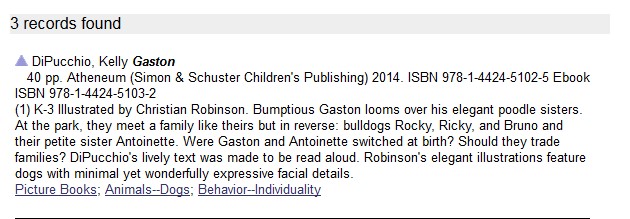 …but Where Oliver Fits leads me to try Self-acceptance as a keyword.
…but Where Oliver Fits leads me to try Self-acceptance as a keyword.  So then I have a new search to do. And so on. This is not a short process. I spend hours creating my submissions list for a manuscript before I start sending it out. I try to come up with at least 10 markets, each with a specific editor’s name, and each with at least one comp title to mention. I’m not saying I’m always successful at all of that, but that’s the goal. Good luck! We’re almost to the end of the series. Next, I’ll talk briefly about how I decide how and in which order to submit!
So then I have a new search to do. And so on. This is not a short process. I spend hours creating my submissions list for a manuscript before I start sending it out. I try to come up with at least 10 markets, each with a specific editor’s name, and each with at least one comp title to mention. I’m not saying I’m always successful at all of that, but that’s the goal. Good luck! We’re almost to the end of the series. Next, I’ll talk briefly about how I decide how and in which order to submit!
Part 6: Submit! I have always loved logic puzzles. You know, the kind that start out, “Alfred, Benjamin, Christopher, and Devonte all live on Main Street. They have an elephant, a fish, a greyhound, and a horse as pets. They are an ice cream maker, a juggler…” Then they give you some clues, like, “The person who has a pet giraffe is not the juggler.” And you chart everything out and try to figure out which person goes with which pet and job and so on.
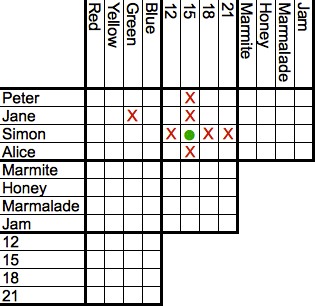
Submitting manuscripts is a lot like a logic puzzle. There are a lot of ways to figure it out, and each step affects the next step. My process is rather intuitive and amorphous, which is no help to you! So, in the spirit of being practical, here are the basic rules I try to follow. Remember, this is AFTER I have created a marketing list for each manuscript, come up with words and phrases to describe my manuscript, and identified specific editors and comparable titles (when possible).
- I make submissions monthly. You might choose to do yours every other Friday, every Wednesday afternoon…whatever works for you.
- I try to keep each manuscript out to 2–3 editors at a time, unless I specifically wrote it with a particular editor in mind or I am submitting to an editor who only considers exclusive submissions (a rarity). I mention in my cover letter that the manuscript it out with one or two other editors.
- I do not submit a manuscript to an editor who already has a manuscript of mine that she hasn’t replied to yet.
- Once an editor replies, I generally wait a month before sending that person something new. I don’t want an editor to—consciously or not—delay replying to me because she knows something else will hit her inbox IMMEDIATELY.
- I do not send a manuscript to another editor at the same imprint or publishing house if one editor there has already rejected it. Some of the Big Five publishers have numerous imprints working independently, and it’s okay to submit to different imprints in that case. For example, MacMillan owns Farrar, Straus and Giroux and Henry Holt and Company. I would possibly submit a book to one after the other rejected it, IF I felt the book matched both publishers.
- I do not send a revised manuscript to an editor who sent me personal feedback UNLESS the editor indicated a willingness to see a revision.
So, each month, usually near the end of the month as I’m realizing, “Oh, crap, I haven’t made my submissions this month,” I sit down to send out manuscripts. Here’s where I consult my submissions plan database (excerpt below):  In my chart, yellow=possible market; pink=has the ms currently; blue=already rejected the ms. I go through my listing of manuscripts and identify:
In my chart, yellow=possible market; pink=has the ms currently; blue=already rejected the ms. I go through my listing of manuscripts and identify:
1) which manuscripts are not out with three editors
2) which of the editors I regularly submit to don’t have anything from me right now
Then I begin the dance of matching manuscripts to editors. Maybe I have two in mind to send Cowboys to, but then further down the list, I realize one of those two is just PERFECT for Houseboat. So I send Cowboys to the other and Houseboat to the second one. Maybe a reply I get to one manuscript will affect other manuscripts. For instance, I recently got a rejection where the editor told me she really liked a manuscript but had a preschool-themed picture book coming out soon so wasn’t in the market for that. Well, I had that editor down as a possible market (yellow box) for a different preschool-themed picture book, too. So, I had to get rid of that other yellow box so I wouldn’t submit that particular ms to her in the future. It takes a lot of listing, shuffling, and crossing people out, but eventually I have my list of what I’m going to send where that month.
There are tons of good resources for actual query/cover letter writing, including the e‑book Lisa Bullard and I wrote, How to Query. Here’s a good article by Jo Hart on the topic, too. And a search on Google will bring up plenty more resources. Really, writing the query or cover letter is the easy part, once you do it a few times. Hopefully, this series has helped you complete all the preliminary steps you need to do so that you’re submitting to the right editor with an accurate and compelling description of your wonderful manuscript! Good luck!



